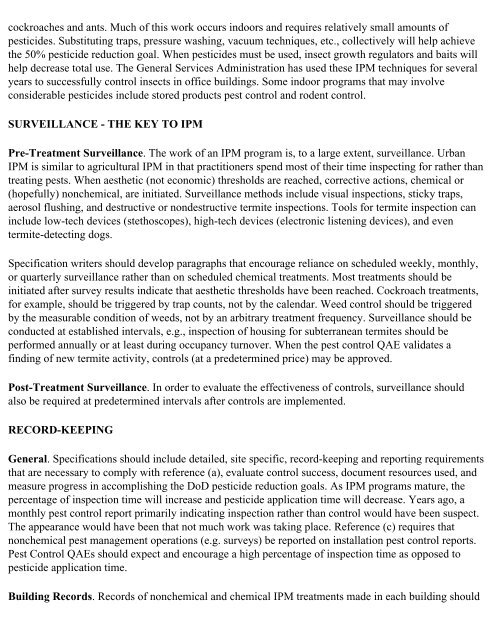Guidelines for Preparing DoD Pest Control Contracts Using ...
Guidelines for Preparing DoD Pest Control Contracts Using ...
Guidelines for Preparing DoD Pest Control Contracts Using ...
Create successful ePaper yourself
Turn your PDF publications into a flip-book with our unique Google optimized e-Paper software.
cockroaches and ants. Much of this work occurs indoors and requires relatively small amounts ofpesticides. Substituting traps, pressure washing, vacuum techniques, etc., collectively will help achievethe 50% pesticide reduction goal. When pesticides must be used, insect growth regulators and baits willhelp decrease total use. The General Services Administration has used these IPM techniques <strong>for</strong> severalyears to successfully control insects in office buildings. Some indoor programs that may involveconsiderable pesticides include stored products pest control and rodent control.SURVEILLANCE - THE KEY TO IPMPre-Treatment Surveillance. The work of an IPM program is, to a large extent, surveillance. UrbanIPM is similar to agricultural IPM in that practitioners spend most of their time inspecting <strong>for</strong> rather thantreating pests. When aesthetic (not economic) thresholds are reached, corrective actions, chemical or(hopefully) nonchemical, are initiated. Surveillance methods include visual inspections, sticky traps,aerosol flushing, and destructive or nondestructive termite inspections. Tools <strong>for</strong> termite inspection caninclude low-tech devices (stethoscopes), high-tech devices (electronic listening devices), and eventermite-detecting dogs.Specification writers should develop paragraphs that encourage reliance on scheduled weekly, monthly,or quarterly surveillance rather than on scheduled chemical treatments. Most treatments should beinitiated after survey results indicate that aesthetic thresholds have been reached. Cockroach treatments,<strong>for</strong> example, should be triggered by trap counts, not by the calendar. Weed control should be triggeredby the measurable condition of weeds, not by an arbitrary treatment frequency. Surveillance should beconducted at established intervals, e.g., inspection of housing <strong>for</strong> subterranean termites should beper<strong>for</strong>med annually or at least during occupancy turnover. When the pest control QAE validates afinding of new termite activity, controls (at a predetermined price) may be approved.Post-Treatment Surveillance. In order to evaluate the effectiveness of controls, surveillance shouldalso be required at predetermined intervals after controls are implemented.RECORD-KEEPINGGeneral. Specifications should include detailed, site specific, record-keeping and reporting requirementsthat are necessary to comply with reference (a), evaluate control success, document resources used, andmeasure progress in accomplishing the <strong>DoD</strong> pesticide reduction goals. As IPM programs mature, thepercentage of inspection time will increase and pesticide application time will decrease. Years ago, amonthly pest control report primarily indicating inspection rather than control would have been suspect.The appearance would have been that not much work was taking place. Reference (c) requires thatnonchemical pest management operations (e.g. surveys) be reported on installation pest control reports.<strong>Pest</strong> <strong>Control</strong> QAEs should expect and encourage a high percentage of inspection time as opposed topesticide application time.Building Records. Records of nonchemical and chemical IPM treatments made in each building should
















